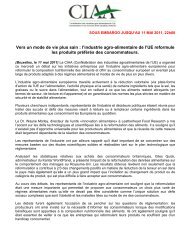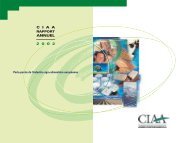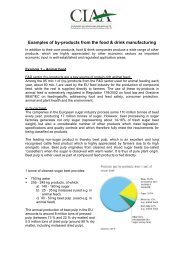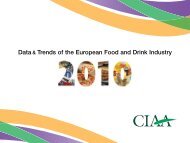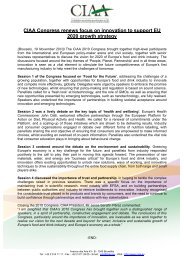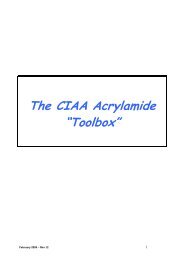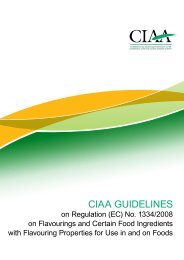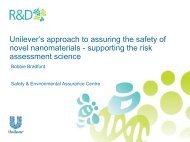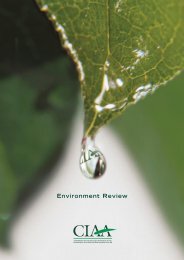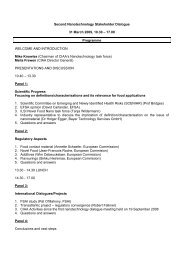Anne Theobald - FoodDrinkEurope
Anne Theobald - FoodDrinkEurope
Anne Theobald - FoodDrinkEurope
You also want an ePaper? Increase the reach of your titles
YUMPU automatically turns print PDFs into web optimized ePapers that Google loves.
EFSA’s guidance in the field of<br />
nanotechnologies<br />
4 th Nanotechnology Stakeholder Dialogue Day<br />
`Potential food applications of nanotechnologies`<br />
Brussels, 5 October 2011<br />
<strong>Anne</strong> <strong>Theobald</strong> – Senior Scientific Officer<br />
Scientific Panel on food contact materials, flavourings,<br />
enzymes and processing aids (CEF) Unit
EFSA‘s opinions on<br />
Nanotechnologies<br />
Two mandates from the European Commission:<br />
• In 2007 a request was received and an opinion adopted<br />
by the Scientific Committee in 2009<br />
• In 2009, a follow-up request was received and a<br />
guidance opinion adopted by the Scientific Committee in<br />
April 2011<br />
2
1. Opinion – Terms of Reference<br />
• to produce a scientific opinion on the need for specific<br />
risk assessment approaches for<br />
technologies/processes and applications of nanoscience<br />
and nanotechnologies in the food and feed area.<br />
• to identify the nature of the possible hazards<br />
associated with actual and foreseen applications in the<br />
food and feed area<br />
• to provide general guidance on data needed for the<br />
risk assessment of such technologies and applications.<br />
3
1. Opinion – Conclusions<br />
• The opinion is generic in nature and is not in itself a risk<br />
assessment of nanotechnologies as such or of tentative<br />
applications or possible uses thereof or of specific<br />
products.<br />
• It considers Engineered Nanomaterials (ENM) and.<br />
• It provides generic guidance for risk assessment.<br />
4
1. Opinion – Conclusions<br />
• The current risk assessment paradigm is applicable<br />
for ENM.<br />
• The nanospecific properties and characteristics of ENM<br />
are likely to affect their toxicokinetic behaviour and<br />
toxicity profile.<br />
• Uncertanties e.g. measurement , exposure and<br />
toxicological data.<br />
• The risk assessment of ENM has to be performed on a<br />
case-by-case basis.<br />
5
http://www.efsa.europa.eu/fr/scdocs/doc/sc_op_ej958_nano_en, 0.pdf<br />
6
2. Opinion: Terms of Reference<br />
(1) EFSA is requested to prepare a guidance document<br />
… (including food additives, enzymes, flavourings, food<br />
contact materials, novel foods, food supplements, feed<br />
additives and pesticides).<br />
(2) This document should provide practical<br />
recommendations for the risk assessment of food<br />
related applications of nanotechnology to the extent<br />
possible with current knowledge.<br />
In the cases where knowledge is insufficient, it should<br />
indicate the endpoints and/or parameters that would<br />
have to be known in order to carry out a risk<br />
assessment.<br />
7
2. Opinion: Terms of reference<br />
(cont’d)<br />
(2) Consultation with stakeholders: The proposed guidance<br />
document should be subject to public consultation<br />
and if deemed appropriate discussed with stakeholders<br />
in a dedicated meeting prior to its adoption.<br />
(3) Follow-up: Subsequent to these opinions, the<br />
Commission invites EFSA to monitor scientific<br />
advances and keep the Commission informed on<br />
relevant developments and, when appropriate, to revise<br />
the draft document.<br />
8
http://www.efsa.europa.eu/en/efsajournal/doc/2140.pdf<br />
9
General considerations<br />
• Risk assessment paradigm is applicable<br />
• Reference to existing guidelines in various food and feed<br />
areas for the non-nano form<br />
• Provide guidance on nano specific considerations that<br />
need to be assessed in addition to conventional aspects<br />
(e.g. additional information on physico-chemical<br />
properties)<br />
• In principle also applicable for contaminants<br />
• Uncertainty analysis<br />
• Acknowledges fast scientific development and the need<br />
for update of the guidance document<br />
10
Characterisation at several steps<br />
• As manufactured (pristine state)<br />
• Prior to use in food/feed (as delivered to producer)<br />
• As used in food/feed<br />
• As used for toxicological testing<br />
• In biological fluids and tissues<br />
– Lays down parameters for characterisation and<br />
identification<br />
– Methods used need to be carefully selected and<br />
described and demonstrated to be fit for purpose<br />
– Acknowledged that characterisation can be difficult in<br />
certain matrixes<br />
11
Exposure scenarios<br />
• Outline anticipated exposure scenarios as this will<br />
influence the extent of the hazard characterisation.<br />
– Direct or indirect addition to food/feed<br />
– Certain applications may give rise to a very limited<br />
exposure<br />
– Where ENM exposure is not detected by appropriate<br />
methods, conventional risk assessment should be<br />
considered for any non-nanoform fraction<br />
(degradation)<br />
12
Toxicity Testing Outline<br />
1. No persistence of ENM in preparations (as marketed)<br />
2. No migration from food contact materials<br />
3. Transformation in the food/feed matrix before digestion<br />
4. Transformation during digestion<br />
– In vitro studies<br />
5. Information on non-nanoform available (if present in food/GI)<br />
– Compare genotox, ADME and repeat dose 90-day study<br />
6. No information on non-nanoform available (if present in<br />
food/GI)<br />
– Provide full data according to relevant EFSA guidance for<br />
intended use, with modifications to tests as proposed<br />
13
No<br />
Consider need for further testing<br />
E.g.<br />
No migration from FCM<br />
•Follow EFSA FCM Guidance<br />
Transformed to non-nanoform in<br />
food/feed matrix before ingestion<br />
•Follow relevant EFSA Guidance for nonnanoform<br />
Yes<br />
Assess local GIT effects and possible ENM<br />
absorption before transformation<br />
Test according to relevant EFSA Guidance for nonnanoform<br />
or refer to existing data*<br />
ENM Present in Food/feed?<br />
Yes<br />
ENM absorbed from the GIT?<br />
(e.g. from assessment of stability in GI fluids<br />
or ADME data)<br />
No<br />
ENM is completely<br />
transformed into nonnanoform<br />
in the GIT?<br />
No<br />
Yes<br />
ENM is not (or only partially) transformed into<br />
non-nanoform<br />
In vitro tests:<br />
Genotoxicity<br />
•Gene mutations in mammalian cells test<br />
•In vitro micronucleus test<br />
In vivo tests**:<br />
ADME<br />
Repeated-dose 90-day oral toxicity<br />
In vivo genotoxicity (if positive in vitro or not testable in<br />
vitro)<br />
14
Exposure assessment<br />
• Determination of the amount present in food/feed<br />
• Estimate worst case exposure unless information<br />
suggest otherwise.<br />
– Assume that all added ENM is present, ingested and<br />
adsorbed in the nanoform.<br />
15
GUIDANCE????<br />
16
Guidance documents for RA<br />
Specific guidance documents are already in place for the<br />
RA in the following areas:<br />
• Food additives<br />
• Food supplements<br />
• Food contact materials<br />
• Active and Intelligent Packaging<br />
• Flavouring substances<br />
• Pesticides<br />
• GMOs and GMMs<br />
• Feed<br />
17
Guidance documents for RA<br />
Relate to preparation and submission of a dossier for<br />
safety evaluation of substances by a producer<br />
- before it can be placed<br />
on the market<br />
- for re-evaluation<br />
18
Data requirements in Guidance<br />
documents<br />
Some elements are common:<br />
• Identification of substance<br />
• Manufacturing process<br />
• Dietary exposure<br />
• Toxicological studies<br />
Some information is specific:<br />
• Environmental fate (pesticides, feed additives)<br />
• Occupational health (pesticides, feed additives)<br />
• Migration data into food (food contact materials)<br />
19
EFSA risk assessment of ENM<br />
So far only two assessments have been provided by<br />
EFSA on risks of specific nanomaterials in food and<br />
feed:<br />
o ANS Panel: Submitted data were insufficient to<br />
adequately characterise silver hydrosol and the<br />
Panel could not provide an opinion.<br />
o CEF Panel: No safety concern for titanium nitride for<br />
use as food contact material on the basis of absence of<br />
migration into food simulant.<br />
20
EFSA Re-evaluation of food<br />
additive by the ANS Panel.<br />
Calcium carbonate (E170)<br />
– Total number of particles with diameter less than 100<br />
nm less than 1 %.<br />
– A range of toxicological studies have been performed<br />
with calcium carbonate described as nanoform<br />
– none of these provided comprehensive data on<br />
characterisation of the nano material<br />
– nor do these studies provide a full toxicological<br />
database in line with the guidance provided by EFSA<br />
Scientific Committee Opinion<br />
21
Thank you for your interest!<br />
anne.theobald@efsa.europa.eu<br />
http://www.efsa.europa.eu/<br />
22




